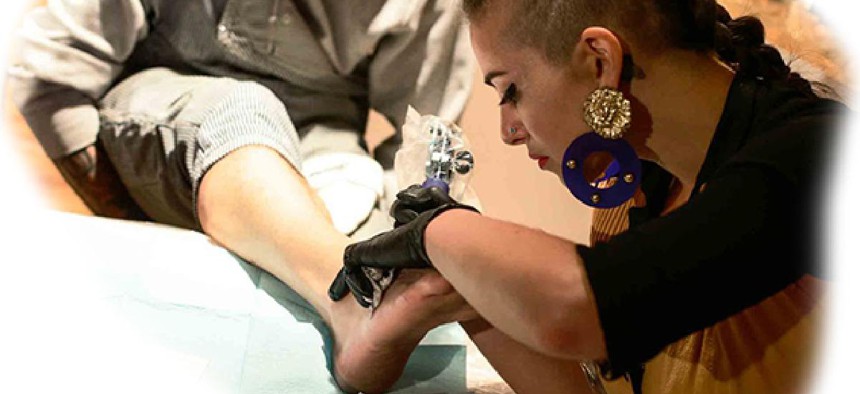Sex Work Art Work: New York sex workers against sex trafficking

Photos by Kate Ryan for NYN Media
An unlikely crowd gathered Wednesday for a Valentine’s Day art show in Manhattan’s South Street Seaport. Philanthropists, activists, artists and sex workers came adorned in pinks and reds to raise funds for two causes: an end to sex trafficking and the empowerment of New York’s sex workers.
“A lot of people think to support sex workers is to negate the experience of people who suffer through human trafficking, and they’re not the same thing,” said Jacqueline Frances, an artist and sex worker. “It’s important that we have the conversation, because it’s uncomfortable.”
It’s the first time Beauty for Freedom, a New York City-based nonprofit working to end trafficking, has benefitted from a fundraiser that supported sex workers at the same time.

Sex trafficking is the exploitation by force or coercion of a person for unpaid labor or sex. The sex workers involved in this art show are paid professionals who serve strip clubs or work independently.
The woman behind “Sex Work Art Work” is Zephy.
“I think people think of sex trafficking maybe in Ghana, in Cambodia. But it's right behind us,” she said.
Zephy’s childhood friend was trafficked and found dead in the Bronx when they were 16.
“I was in a nice area in Vermont, and she was a foster kid who slipped through the cracks. She was a real victim of very smart and calculated people who knew exactly who to take advantage of, because the system doesn't support them enough.”
She has been a sex worker for almost 10 years and dabbled in art when she moved to New York and found Beauty for Freedom.
Founded in 2014 by Monica Watkins and Jerry Chu, Beauty for Freedom has reached over 1,500 victims and survivors of trafficking. It has also donated more than $50,000 in food, clothing and art supplies to nonprofits fighting trafficking around the world all while operating on an annual budget of around just $55,000. The organization relies heavily on volunteers like Zephy, who Watkins calls “ambassadors.”
Nowadays, Zephy splits her time as a volunteer and art therapist for Beauty for Freedom and as a sex worker. She said sex work is not only a legitimate job, but one of the oldest jobs around, and it is time to empower workers and disempower traffickers. Her personal mission is to bring stigmatized communities “out of the dark.”
Sex Work Art Work is the first event that was conceptualized and produced by someone other than Beauty for Freedom’s co-founders. Watkins says Zephy was ready for the challenge. Zephy spent four months coordinating the art exhibition that will remain open for nine days. The eleven contributing artists are local sex workers and their allies. Their work validates the range of human experience on the job, said Zephy. Prices range from $100 to $35,000. Artists will receive 50 percent of the proceeds and Beauty for Freedom’s upcoming programming in Ghana and Mumbai will receive the other 50 percent.

“Sometimes I call myself a ‘Robin Ho,'" said Zephy. “I'm really good at (saying) 'Let me see who can support me so I can support these people and get this together.”
Beauty for Freedom works in the United States to teach and empower students to spread awareness of trafficking and intimate partner violence. Abroad, "ambassadors" teach survivors and other vulnerable populations art therapy, self-care and offer other skill-building workshops that may lead to alternative employment. Photographers and artists like Zephy run workshops that often result in community art projects like murals or photography books. The organization relies almost entirely on donations and fundraising for its operational budget. Organizations like Airbnb, WeWork, Vita Coco and Lululemon contribute in-kind donations.
“I call it the little engine that can,” said Watkins about her budget which has increased by 40 percent over the last year. Most funds, said Watkins, come from individuals buying art work or products at fundraising events.
Over the next few years, Watkins hopes to develop workshops for survivors in New York and in her home state of Texas – the state with the fourth highest incident of trafficking cases. Zephy did have reservations about being the face of this charity event because of how her career as a sex worker might be perceived.
Watkins had to think about her donors and whether supporting a night that was both anti-trafficking and pro-sex workers would go over well. But she gave Zephy her full support, and she feels strongly that she made the right decision.
"I came as a cis female-identifying affluent white woman who's very empowered by my work into this place of extraordinary tragedy and pain," said Zephy about her first involvement with Beauty for Freedom in Cambodia.
“But it's really the biggest difference in the world: Choice. I'm empowered because I have the rights and the opportunity, and I'm respected in my community. And these people have everything taken from them."
Shannon Mac Ardhail, another ambassador for Beauty for Freedom and a friend of Zephy’s, pointed out that almost all the artists for Sex Work Art Work were women. “It’s something to be talked about today, women having autonomy over their bodies and careers,” he said.
Zephy said that not everyone is going to meet a sex worker or actively seek one out, but only by meeting one can people begin to humanize one another.
“It provides an opportunity, a step in the right direction, taking all this stuff out of the dark, maybe giving a safe space to have a conversation with someone who doesn't think like you,” said Zephy. “And I think that does volumes for breaking a stigma.”
Sex Work Art Work can be viewed at 264 Water St., New York City until February 22. For appointments with the curator, email hello [at] hellozephy.com.
